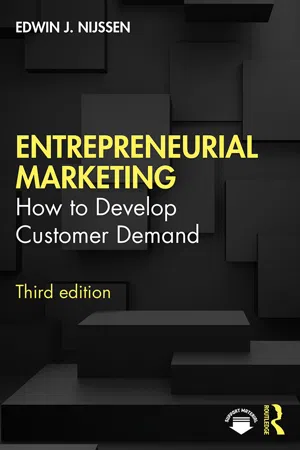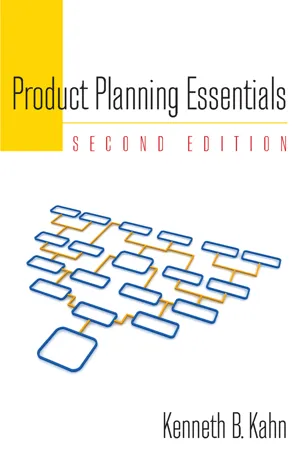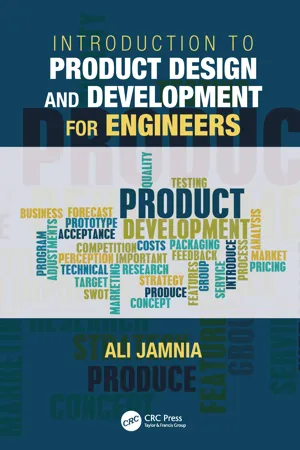Product Development Process
The product development process involves the steps taken to bring a new product from concept to market. It typically includes idea generation, market research, design, testing, and commercialization. This process is crucial for companies to create successful products that meet customer needs and achieve business objectives.
8 Key excerpts on "Product Development Process"
- eBook - ePub
Engineering Textiles
Integrating the Design and Manufacture of Textile Products
- Yehia Elmogahzy(Author)
- 2019(Publication Date)
- Woodhead Publishing(Publisher)
...Key elements of product development will include the following: (1) generating product idea, (2) determining and defining anticipated product performance characteristics and related attributes and requirements, (3) the information-gathering process, (4) evaluating the merits of the new idea to justify proceeding forward, (5) design conceptualization and design analysis, (6) mass manufacturing, and (7) marketing. 3.2 What is product development? In general, product development can be defined as the process of creating new products with added or different characteristics in comparison with existing products for the sake of offering additional benefits to consumers and maintaining or increasing the profitability of the product's provider. In other words, any product development should result in mutually beneficial outcomes to both the maker and the user of the product. Product development may also be defined as a system with well-defined inputs, such as specifications of a new product idea or solutions of existing product problems, and well-defined outputs such as measurable beneficial factors such convenience characteristics, product's ease to use, and revenues/profits for product's makers. Both definitions constitute the typical journey of product development in most organizations. The complexity of today's Product Development Process is reflected in many iterative aspects most of which are implemented without guarantee that the product will ultimately be attractive to consumers. It involves many disciplines including engineering, manufacturing, market research, marketing, safety and regulations, business, sales, and accounting. The common focus of all these disciplines is always the consumer or the buyer of the product. Therefore, each discipline must operate based on forward-thinking and backward projection (user feedback) analysis. This makes product development essentially an iterative process...
- eBook - ePub
Entrepreneurial Marketing
How to Develop Customer Demand
- Edwin J. Nijssen(Author)
- 2021(Publication Date)
- Routledge(Publisher)
...It is core to entrepreneurship. It involves several steps, including new product idea generation and selection, concept development, prototyping, market testing, and launch. While at every stage of the process both technical and marketing issues co-exist, 3 most entrepreneurs (but also many large firms) limit marketing and sales’ effectiveness by leaving it till the end. They first develop the new product and then hand it to marketing and salesperson, telling them: ‘Now do your best.’ So “[w]hile customer input may be a checkpoint or ‘gate’ in the [new product development] process it [often] doesn’t drive it”. 4 This approach is a road to disaster. The winners at the game of new product development follow a different approach; they invent and live by a process of discovery and experimenting with customers in order to learn. 5 Consistent with this, Blank 6 suggested that start-ups should complement their new Product Development Process with a formal customer development one. He coined the term ‘customer development’ and used it to describe the parallel process of building a continuous feedback loop with customers throughout the product development cycle. This customer development process concerns locating a start-up’s first customers, validating its assumptions about customer needs and behaviour, and growing its business by extending its small, initial customer base. Figure 7.1 The complementary processes of new product and customer development Figure 7.1 shows the two parallel processes of new product and customer development. We show them as complementary phenomena with serious, and preferably systematic, information exchange between them...
- eBook - ePub
Innovation, Product Development and Commercialization
Case Studies and Key Practices for Market Leadership
- Dariush Rafinejad(Author)
- 2007(Publication Date)
- J. Ross Publishing(Publisher)
...THE Product Development Process According to the Software Engineering Institute at Carnegie Mellon University, a process is a sequence of steps performed for a given purpose. A process integrates people (with skills and motivation), tools, tasks, and procedures (which defines the relationship of tasks). This chapter is devoted to the process of product development. The various phases of product development are discussed. Guidelines for the key tasks of new product development are also presented, including the content of key documents and the roles and responsibilities of core team members. Because of their unique characteristics, additional sections are devoted to a discussion of new process and new software development. A brief review of selected Product Development Processes that are reported in business literature and practiced by leading global companies is presented in Section 5.2. Subsequently the recommended process for development and commercialization of a new product (PDCP) based on cited best-known methods and the author’s experience is outlined. [ Note : Consult Kahn (2005), 1 Belliveau and Griffin (2002), 2 and Belliveau, Griffin, and Somermeyer (2004) 3 for additional information.] Chapter 5 concludes with sections discussing product release and life cycle change management. A Product Development Process is comprised of several distinct phases (E&F, alpha, beta, and gamma). Each phase accomplishes an important objective toward an end goal of commercial success, and the roles of key players change during each phase change, including marketing, engineering, manufacturing, suppliers, and management. (The goals of a Product Development Process are discussed in Chapter 4. Figure 4.1 provides metrics that can be used to measure the effectiveness and efficiency of a product innovation, development, and commercialization process.) PDCP implementation methodology is strongly dependent upon the type of product that is being developed...
- eBook - ePub
Ergodesign Methodology for Product Design
A Human-Centered Approach
- Marcelo M. Soares(Author)
- 2021(Publication Date)
- CRC Press(Publisher)
...3 The Product Design Process DOI: 10.1201/9781003214793-3 The concepts of Product Development and Product Design Process are presented. The chapter discusses what the product should do to meet the user’s needs and presents a wide range of bibliographic references in several important areas for product design. The various stages of the consumer product design process (Design Specification, Concept, Modeling and Prototyping, Product Evaluation, Production and Marketing, and Further Evaluation) are presented and analyzed. Special attention is given to product safety which includes an analysis of human error and responsibilities in product design and manufacturing. Attention must be given to product liability which usually results from the application of negligence, breach of warranty, or strict liability in tort. 3.1 Product Development and the Product Design Process According to Kotler and Armstrong (2018): A product is anything that can be offered to a market for attention, acquisition, use or consumption that might satisfy a want or need. It includes physical objects, services, persons, places, organizations, and ideas. Additionally, Product Development (which comprises the product design and engineering process) is the set of activities beginning with the perception of a market opportunity and ending in the production, sale, and delivery of a product (Ulrich and Eppinger, 2019). This concept applies to products aimed at the non-disabled and disabled user. Smith (2013) ponders that although products or services satisfy a want or a need, some market segments – car manufacturers, for example – do not sell the product itself; they sell the skills of their workforce, self-esteem, comfort, safety, and style. The product is part of the medium through which these needs and wants are satisfied...
- eBook - ePub
- Kenneth Kahn(Author)
- 2014(Publication Date)
- Routledge(Publisher)
...Many times, bottlenecks due to technology problems or market changes force a change in the expected course of action. Many companies, nonetheless, provide a schematic of their Product Development Process to frame expectations for their product development initiatives. In this way, company personnel understand the general steps and criteria necessary to get products to the marketplace. The following are criteria that any good Product Development Process should have: • The process should provide some structure of checkpoints along the way. • The process should allow the product development team and its support group substantial degrees of freedom. • The new Product Development Process must be flexible to accommodate changing conditions. • The new Product Development Process must deal with especially critical points in development. • The new Product Development Process should integrate the team with the rest of the firm and the world. • The new Product Development Process should permit a smooth launch. • The new Product Development Process should provide for organization learning. Note that even if a Product Development Process exists, companies can abuse how the process is used. These abuses include the following: • Too much faith in the product being developed • Lack of concern for the customer • Faulty research (skewed findings) • Meeting technical needs and certain customer needs, but not all customer needs Special attention needs to be taken to ensure that these abuses do not emerge, or else the respective Product Development Process will not reach its potential for success. Implementing a Product Development Process While many companies have a structured Product Development Process, other companies do not have a process...
- Dr. Ali Jamnia(Author)
- 2018(Publication Date)
- CRC Press(Publisher)
...Admittedly, there are references that attempt to explain product development methodology from an engineering point of view. Among these are David Ullman (2010) in The Mechanical Design Process, Gerhard Pahl et al. (2007) in Engineering Design: A Systematic Approach, and Stuart Pugh (1991) in Total Design: Integrated Methods for Successful Product Engineering. Ogrodnik (2013) provides a critical review of the models proposed by Pugh as well as Pahl and Beitz. He eventually concludes that, “While these models are worthy, in reality they do not give a full picture of actual activity. They visualize the processes but not the activities. To this extent I shall present a didactic model.” Then he provides a “divergent-convergent” model of his own. I am not really sure if there is a great deal of difference between these various models, per se. As I mentioned earlier, almost all begin with a reference to a market need and end with the embodiment of a product. A few have even mentioned the need for sustaining the product and eventually removing it from the market. An often-forgotten (or ignored) factor is that even though most of the models present their various steps and stages in a linear fashion, in reality, product development is a highly iterative process, either within each step or between two or several stages. Another overlooked factor is that product development is never a purely engineering, purely sales and marketing, or purely business activity. It is truly an interdisciplinary and interwoven set of activities whose success depend on various teams working together. The shortcomings of many models may be because the activities required in the Product Development Process are not visualized. Or, if they are referenced, they are considered within a specific discipline, such as, say, engineering, finance, or marketing. I agree with Ogrodnik (2013) that any proposed model should present both the process as well as the activities...
- eBook - ePub
Market Research in Practice
An Introduction to Gaining Greater Market Insight
- Paul Hague(Author)
- 2021(Publication Date)
- Kogan Page(Publisher)
...The percentage filter depends on a number of factors such as the pricing strategy and planned promotional investment. STAGE 3: PRODUCT DEVELOPMENT At this stage in the Product Development Process, prototypes are manufactured. Market research is less common in this early phase of manufacturing, but in some cases, a quick and small-scale customer review of the prototype is useful for identifying any major pitfalls, allowing for product changes before a full-scale production run. STAGE 4: TEST AND VALIDATION Once the prototype has met the quality standards, it is recommended that it is tested among the target audience. Product trials enable the user to provide valuable feedback indicating necessary changes to the physical product, as well as informing marketing and pricing strategies. The research objectives of product trials are very similar to those of concept tests. It is beneficial in product trials to also explore comparisons with current products used in order to determine the biggest differentiators of the new offering. In business-to-business markets, this often requires research with the users of the product who may be a separate audience from the decision makers. While decision makers have the final say, users know the products the best and can have a substantial influence on their managers. STAGE 5: LAUNCH AND MONITOR The final stage entails the full-scale production and launch of the new product. The success of the new product is as much down to the channel, pricing and promotional strategies as it is to the features of the product itself. Market research can be used post launch to monitor the product’s performance beyond the sales figures...
- eBook - ePub
Essential Tools for Operations Management
Tools, Models and Approaches for Managers and Consultants
- Simon Burtonshaw-Gunn(Author)
- 2010(Publication Date)
- Wiley(Publisher)
...CHAPTER 3 PRODUCT DEVELOPMENT INTRODUCTION This chapter looks at product or services development with an obvious linkage to the other chapters of business planning and supply chain management. Product development can take either one of two approaches: it may be a modification to an existing product with a focus on market sustainment, or it may produce market disruption by offering new products or significantly enhanced features such as simplicity, ease to use, lower costs and so on. After some general considerations, both of these approaches to product development are explored in further detail. Whilst the focus is generally on physical products, many of the models and narrative can be equally applied to the provision of services. UNDERSTANDING PRODUCTION A good start to understanding product development is first to consider the three traditional “classes of production”, these being: • Primary production which is the earliest stage in the production process such as that witnessed in mining, farming, oil extraction, tree-felling, etc. • Secondary production involves converting the primary production raw materials into finished, or part-finished, goods either through constructing, manufacturing or other forms of processing. • Tertiary production describes the activities of the services sector of the economy with examples such as retail, insurance, banking and direct services to the public such as policing, nursing, etc. which rely on the products of the two above classes to create their working environment. Product management as a necessary part of production can be undertaken as a management activity in any of the above three “classes of production” and is widely regarded as a collective term used to describe a broad sum of diverse activities performed in the interest of delivering a particular product to an intended market...







